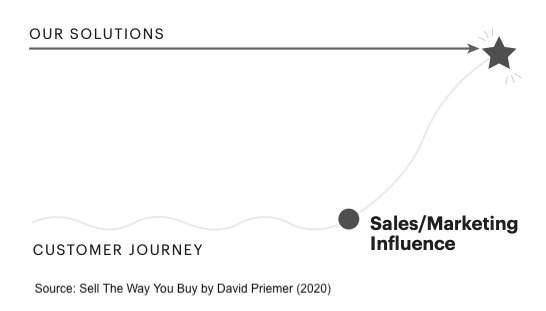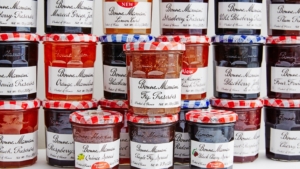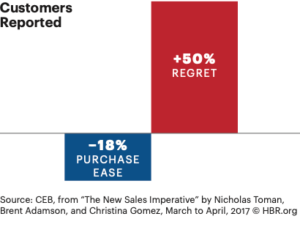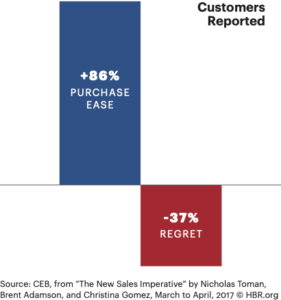Stop Selling and Start Telling: The Power of Prescription
One of the biggest misconceptions sellers have is that customers know exactly what they’re looking for.
In a 2019 letter to Amazon shareholders, founder and CEO Jeff Bezos included a short narrative about the success of the Amazon Echo smart-home device, underscoring the importance of taking a leadership role when it comes to ushering customers down the path to their purchase. He states:
Market research doesn’t help. If you had gone to a customer in 2013 and said “Would you like a black, always-on cylinder in your kitchen about the size of a Pringles can that you can talk to and ask questions, that also turns on your lights and plays music?” I guarantee you they’d have looked at you strangely and said “No, thank you.”
The truth is, customers in the market for a product or service aren’t always clear about the problem they’re looking to solve and the variety of ways potential solutions can solve it. That means creating awareness around our solutions is critical when it comes to winning the attention of our buyers. But equally important is the ability to shape our customer’s journey, needs, and requirements so that they intersect with our solution.

Greater Choice = Fewer Sales
You might think that the incredible choice in solutions and product variations that exists in today’s market, combined with the widespread availability of research, insights, and reviews, has made it easier for buyers to pick the best solutions for them. But you would be wrong.
In 2000, a series of behavioral science experiments were conducted by Columbia and Stanford University researchers to investigate the impact of choice on decision-making. In one experiment the researchers set up a display of gourmet jams in an upscale supermarket. All the jams were made by the same manufacturer, and customers were allowed to sample them as they walked by. To examine the impact of choice the researchers varied the number of jam flavors available to the customers. In one case, six varieties were available. In another, a whopping twenty-four varieties were presented.

The results: of the customers who were exposed to the twenty-four-variety display, only 3 percent went on to make a purchase. When the choice was limited to only six, that number increased tenfold, to 30 percent!
In another example, Procter & Gamble found that when they reduced the number of versions of their popular Head & Shoulders shampoo from twenty-six to fifteen, sales increased by 10 percent. While conventional wisdom might lead us to believe more choice is better, too much choice can often confuse customers. This causes them to disengage from their evaluation process, resulting in the dreaded “no decision” with which modern sellers are all too familiar.
Top Sellers Move From Reactive to Prescriptive
Research from Gartner has shown the same to be true. When the burden of choice is imposed on customers, who are left to approach providers with questions and challenges (in other words, reactive selling), they report a decrease in the ease with which their purchasing decisions are made. They also express far greater regret for their purchases, wondering if they made the right choice, or if another solution would have been a better fit.

For example, suppose you were looking to book a family vacation. You go online and find hundreds of destination, activity, and travel options. After countless hours of painstaking research, you finally narrow down the list of available options to a few that seem reasonable, but you’re not completely sure. You then start reading reviews from fellow travelers to get a deeper sense of how your family would feel about the options, finding a review of a promising all-inclusive resort from Betty in Des Moines, Iowa. “Does Betty have three kids like I do?” you wonder. “Did she travel at peak hurricane season like I’m considering?” “Is she a retired librarian who spends most of her non-vacationing time sitting on the couch knitting?” Who knows! You move from review to review looking for additional guidance, but the clarity you seek never materializes. Eventually, you become exhausted by all the options and reviews. You give up and decide to just book the place and hope for the best. Still not sure if you made the right decision, regret starts to set in.
However, leading your customer through the sea-of-sameness to their purchase decision is rewarded. When modern sellers assume a more prescriptive approach to how their customers should evaluate and purchase their products and services, we see a sharp reversal of these statistics: an 86 percent increase in purchase ease and a 37 percent reduction in buyer regret.

Imagine if, instead of toiling for hours online looking for vacation ideas, you connected with a travel agent who specializes in high-season family vacations. They carefully listen to your needs, desires, and restrictions, and within moments produce a shortlist of three venues that look fantastic. Not only that, the agent drops the names of other parents at your kids’ school who mentioned loving one destination in particular when they vacationed at the same time of year as you. You book it, appreciating not only the simplicity and lack of friction in the buying process, but also the feeling of conviction with which you’re left, knowing that you made a really great decision.
Prescriptive sellers like these sell with conviction. They provide clear, insightful recommendations to their customers and in many ways are able to create intoxicating certainty around the buying process. They bring the future to their customers and make it easy for them to buy.
In part 2 of this post, I cover three ways to inject the power of prescription into your sales motion.
We promise never to send you junk or share your email! Just helpful sales insights.














Can’t wait to read Part 2 and make it part of my framework!
Stay tuned Thomas!
If you sell and get the “group” buying discussion, having 30 flavors of Jam will be a disaster, I’ve found my successful sales have been more roadmapped. get the Strawberry and let’s add another jar when we hit this point. I also like Time to Value in the discussion.